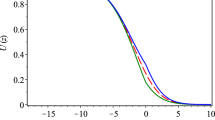Abstract
The Neolithic transition began the spread of early agriculture throughout Europe through interactions between farmers and hunter-gatherers about 10,000 years ago. Archeological evidences indicate that the expanding velocity of farming into a region occupied by hunter-gatherers is roughly constant all over Europe. In the late twentieth century, from the contribution of the radiocarbon dating, it could be found that there are two types of farmers: one is the original farmer and the other is the converted farmer which is genetically hunter-gatherers but learned agriculture from neighbouring farmers. Then this raises the following questions: Which farming populations play a key role in the expansion of farmer populations in Europe? and what is the fate of hunter-gatherers (e.g., become extinct, or live in lower density, or live in agricultural life-style)? We consider a three-component reaction–diffusion system proposed by Aoki, Shida and Shigesada, which describes the interactions among the original farmers, the converted farmers, and the hunter-gatherers. In order to resolve these two questions, we discuss traveling wave solutions which give the information of the expanding velocity of farmer populations. The main result is that two types of traveling wave solutions exist, depending on the growth rate of the original farmer population and the conversion rate of the hunter-gatherer population to the converted farmer population. The profiles of traveling wave solutions indicate that the expansion of farmer populations is determined by the growth rate of the original farmer and the (maximal) carrying capacity of the converted farmer, and the fate of hunter-gatherers is determined by the growth rate of the hunter-gatherer and the conversion rate of the hunter-gatherer to the converted farmer. Thus, our results provide a partial answer to the above two questions.








Similar content being viewed by others
References
Ammerman AJ, Cavalli-Sforza LL (1971) Measuring the rate of spread of early farming in Europe. Man 6:674–688
Ammerman AJ, Cavalli-Sforza LL (1973) A population model for the diffusion of early farming in Europe. In: Renfrew C (ed) The explanation of culture change. Duckworth, London, pp 343–357
Ammerman AJ, Cavalli-Sforza LL (1984) The Neolithic transition and the genetics of populations in Europe. Princeton University Press, Princeton
Aoki K, Shida M, Shigesada N (1996) Traveling wave solutions for the spread of farmers into a region occupied by hunter gatherers. Theor Popul Biol 50:1–17
Barbălat I (1959) Systèmes d’équations différentielles d’oscillations non Linéaires. Rev Math Pures Appl 4:267–270
Berestycki H, Hamel F, Kiselev A, Ryzhik L (2005) Quenching and propagation in KPP reaction–diffusion equations with a heat loss. Arch Ration Mech Anal 178:57–80
Berestycki H, Diekmann O, Nagelkerke CJ, Zegeling PA (2009) Can a species keep pace with a shifting climate? Bull Math Biol 71:399–429
Bouin E, Calvez V (2014) Travelling waves for the cane toads equation with bounded traits. Nonlinearity 27:2233–2253
Bouin E, Henderson C, Ryzhik L (2017) The Bramson logarithmic delay in the cane toads equations. Quart Appl Math 75:599–634
Eliaš J, Mimura M, Mori R (2021) Asymptotic behavior of solutions of Aoki-Shida-Shigesada model in bounded domains. Discrete Contin Dyn Syst Ser B 26:1917–1930
Fisher RA (1937) The wave of advance of advantageous genes. Ann Eugen 7:353–369
Fu S-C (2014) The existence of traveling wave fronts for a reaction–diffusion system modelling the acidic nitrate–ferroin reaction. Quart Appl Math 72:649–664
Hartman P (1982) Ordinary differential equations. Birkhäuser, Boston
Kabir MH, Mimura M, Tsai J-C (2018) Spreading waves in a farmers and hunter-gatherers model of the Neolithic transition in Europe. Bull Math Biol 80:2452–2480
Kolmogorov AN, Petrovsky IG, Piscounov NS (1937) A study of the diffusion equation with increase in the amount of substance, and its application to a biological problem. Bull Moscow Univ Math Mech 1:1–26
Mellars P (1996) The Neanderthal legacy. Princeton University Press, Princeton
Mori R, Xiao D (2019) Spreading properties of a three-component reaction–diffusion model for the population of farmers and hunter-gatherers. Ann I H Poincare-An. https://doi.org/10.1016/j.anihpc.2020.09.007
Tsai J-C, Kabir MH, Mimura M (2020) Traveling waves in a reaction–diffusion system modeling farmer and hunter-gatherer interaction in the Neolithic transition in Europe. Eur J Appl Math 31:470–510
Acknowledgements
The authors are grateful to the anonymous referees for their useful suggestions and comments which improve the exposition of the paper. SCF is supported by MOST (108-2115-M-004-001-). JCT is supported by MIMS of Meiji University, and MOST (107-2115-M-194-011-MY2) and NCTS of Taiwan. MM is partially supported by MIMS of Meiji University.
Author information
Authors and Affiliations
Corresponding author
Additional information
Publisher's Note
Springer Nature remains neutral with regard to jurisdictional claims in published maps and institutional affiliations.
Rights and permissions
About this article
Cite this article
Fu, SC., Mimura, M. & Tsai, JC. Traveling waves for a three-component reaction–diffusion model of farmers and hunter-gatherers in the Neolithic transition. J. Math. Biol. 82, 26 (2021). https://doi.org/10.1007/s00285-021-01585-3
Received:
Revised:
Accepted:
Published:
DOI: https://doi.org/10.1007/s00285-021-01585-3
Keywords
- Neolithic transition in Europe
- Farmers and hunter-gatherer model. Population biology
- Three-component system
- Traveling wave
- Minimal velocity




